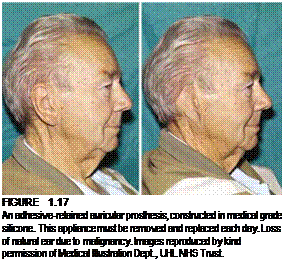Many developments regarding the materials used in the fabrication and coloring of makeup effects appliances as well as the adhesives used to hold them in place have come from the field of anaplastology: the art and science of restoring human anatomy by artificial means.
Generally speaking, the various kinds of prostheses made by anaplastologists include facial, somato (body), and ocular (eye) prostheses.
This is exactly what makeup effects artists do. It is the job of a special makeup effects artist to create prosthetic appliances to be worn by actors that will transform their physical appearance by replicating anatomy as closely as possible, resulting in a natural and lifelike appearance while interfering with the actor’s performance as little as possible.
Just as with prosthetic appliances made for use on stage or screen, even a well – made anaplastic prosthesis may be detectable under close observation. Because
the prostheses are not living tissue, there are some obvious limitations: An anaplastic prosthesis might not restore normal movement, it will not blush or tan, and it must be removed for cleaning.
The process of making prostheses is the blending of art and science. There is very little difference between the methods of designing and fabricating a prosthetic device for everyday use and one created for a stage or screen character, with the possible exception of some of the materials used for the finished appliance. The result of development from silicone breast implant technology, silicone
gel-filled appliances (GFAs) incorporate a tough elastomeric encapsula – tor—usually another silicone used as an outer skin, or envelope—over soft silicone gel that approximates the qualities of human skin over soft fleshy or fatty tissue.
Whereas special effects artists employ the use of foam latex and gelatin as well as silicone as prosthetic appliance materials, anaplastologists do not work with gelatin or foam latex. This is where the major differences stop. The results are dependent on the artistic, clinical, and technical skills of the individual professional. A well-made medical prosthesis serves to restore form whenever possible. Anatomical landmarks; facial proportion; symmetry; the direction of skin folds, skin, and tissue textures; and the coloration of the skin are all taken into account to create a convincing, lifelike appearance. This is no different from what the special makeup effects artist does. The steps in the creation of appliances are virtually identical, too.

 |
 |
Materials used in the creation of anaplastic prostheses include ultra-lightweight silicone and polyurethane. Furthermore, whereas special makeup effects are attached with a variety of medical-grade adhesives, craniofacial implants made of titanium have greatly simplified the daily management of facial prostheses for everyday applications. These titanium anchors do require surgical implantation, however. Some people become anxious about the possibility of a prosthetic appliance coming loose, which causes them to avoid many social activities. Craniofacial implants can give those people the confidence to participate in more activities, which, together with an improved aesthetic appearance, improves their quality of life. The use of these implants has also allowed for the development of new techniques and advanced applications of softer, more flesh-like silicones.
High-consistency silicones with greater tear resistance can be used where edge strength is a priority. The manipulation and mold-packing characteristics of these silicones also produce deeper and longer-lasting intrinsic coloration. Nuances in pigmentation and vascularity can literally be captured with the prosthesis by layering color into the mold prior to polymerization, but this, like any painting technique, relies heavily on the artistic skills of the artist. Achieving the ideal pigment-to-polymer ratio results in a prosthesis that reflects and absorbs light similarly to the adjacent skin. Human skin is not completely opaque, and this balance between opacity and translucence produces a more natural appearance over varied lighting conditions.
The American Anaplastology Association is an organization that serves to bring together those specialties involved in anatomical restorations and to encourage acceptance and understanding of facial and somato prosthetics among healthcare specialties and providers worldwide. Experts from the fields of anaplastol – ogy, maxillofacial prosthetics, medical illustration, ocularistry, prosthetics and orthotics, dental lab technology, prosthetic dentistry (prosthodontics), materials research, clinical cosmetology, biomechanical engineering, medicine, psychology, and other allied fields all participate in the task of improving patient outcomes through research and information exchange. It is through much of this activity that advancements in makeup effects technology occur. Anaplastology is an emerging global profession from which special makeup effects artists can benefit. Their annual conferences and publications offer timely topics on all aspects of restorative prosthetics, as well as conducting workshops on new and innovative developments in biomaterials, technologies, procedures, and approaches.
